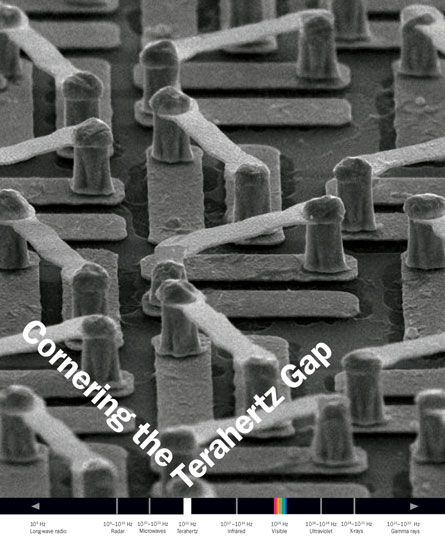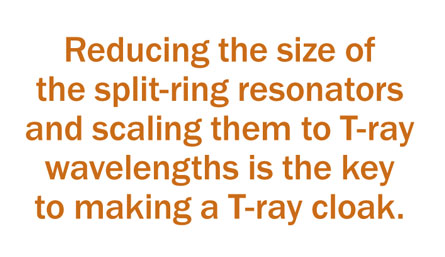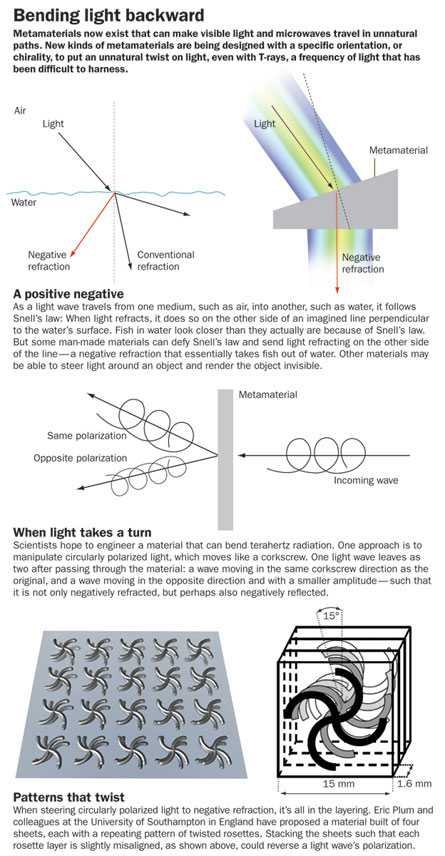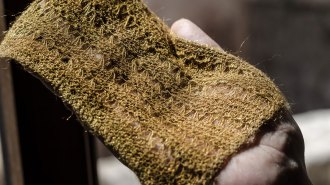Cornering the Terahertz Gap
Controlling light’s path could enable invisibility or harness an intriguing but so far elusive stretch of the spectrum
- More than 2 years ago
Light is a nimble gymnast. It travels in many colors and frequencies. Its waves, whether long or short, can shift to be longer or shorter. Light waves change direction. They bounce.
What light can’t do, on its own at least, is bend backward. In other words, it always refracts or reflects in a predictable, normal direction.
Scientists seeking to make light waves do such unnatural gymnastics have failed to find any natural material that does the job. But in recent years, physicists and engineers have been experimenting with different “metamaterials,” engineered substances that interact with electromagnetic waves in precisely controlled ways. The researchers have made swift progress: Already, they have created metamaterials that can in fact bend light backward. By reversing refraction, these new materials could essentially take a fish out of water, making it appear to float above the water’s surface. Theoretically, the materials also can, just like Harry Potter’s famous cloak, render objects invisible.
Researchers haven’t yet mastered such tricks. But recent advances are improving scientists’ ability to control how metamaterials interact with light, says engineer Xiang Zhang of the University of California, Berkeley.
Metamaterials may also help scientists exploit another form of light called T-rays, or terahertz radiation. T-rays have properties that make them intriguing to scientists. But T-rays have proved extremely challenging to detect, measure and propagate. Thus the name for the region of the electromagnetic spectrum they occupy between the better known microwave and infrared radiation: the terahertz gap.

Terahertz radiation can easily pass through nonmetallic materials such as plastic, fabric, wood and glass, but is partially absorbed by water and gases. These abilities and others make T-rays appealing for a range of potential applications—from biological imaging to quality control (such as detecting an air bubble in a block of foam from the space shuttle) and seeing inside sealed packages. Beginning in the 1990s, researchers have been able to build more cost-effective, practical devices to generate and detect T-rays, including T-ray imagers (SN: 8/26/95, p. 136) and cameras. But the resolution of these devices remains poor, making the technology impractical for widespread use.
Many researchers think that metamaterials engineered to have specific electric and optical properties could harness the power of T-rays to build cameras that watch biological molecules in action; build screening devices that see through materials opaque to visible light; or design spectrometers that “sniff out” biological and chemical agents that X-rays can’t detect. On the flip side, T-ray cloaking devices to fool these terahertz screeners could also be created. Closing the terahertz gap with the help of metamaterials could take the cloaking of weapons, bombs, drugs and other matter out of the realm of magic and into the real world.
“Of course, the science is young and these applications are still in the proof-of-principle stage,” says physicist William Padilla of Boston College. Many technical issues must be worked out before engineers can create devices for improved airport security screeners, spectrometers and invisibility cloaks.
For now, researchers have more experience working with metamaterials tuned to other types of electromagnetic waves, especially visible light and microwave radiation. Some have produced other possibly useful technologies: Reporting in Science in 2007, Xiang Zhang’s group demonstrated that a metamaterials-based lens coupled with a typical optical lens could manipulate visible light to “see” patterns that were too small to be observed with an ordinary optical microscope. A device that detects such fine scales could be used to observe cellular processes, such as how proteins and fats move in and out of cells, currently impossible to watch in action. Or it could be used to improve the first steps of photolithography and nanolithography, essential in the manufacture of smaller computer chips.
Selective spin, a nimble NIM
Metamaterials are engineered structures made of distinct, non–naturally occurring combinations of chemical elements. What makes a metamaterial work is its geometry of repeating structures that, like cookies on a baking sheet, are laid out on repeating layers of film.

A good starter structure for creating a metamaterial is a ring with a small gap in it. Typically, the rings are made of a nonmagnetic metal such as copper and carefully placed on a printed circuit board coated with a metal film. The shape and composition of the rings and, more important, their arrangement determine how the metamaterial responds to light. As electromagnetic waves hit the rings, each ring excites electrical currents in the metal film. The film can either absorb the radiation or reemit it exactly the way researchers design it to.
The gaps in the rings make the material transmit or resonate at a certain frequency, giving these metamaterials the name split-ring resonators. But the ring shape is not the only possibility, says Shuang Zhang, a postdoctoral researcher in the lab of Xiang Zhang (no relation).
The repeating structures can also be formed by single spirals that look like curled Christmas ribbon or layered spirals that resemble pinwheels. The size and shape of each structural element and how the elements are positioned will determine whether the grid effectively guides an electromagnetic ray along a particular path.
Such fine control, Shuang Zhang says, would enable the manipulation of radiation in unnatural ways, such as making light bend or refract backward—negative refraction—or causing it to bend around an object as if the object weren’t there—cloaking.
Metamaterials that achieve negative refraction are called negative index materials, or NIMs. Generally, they are engineered to have both an electric field and magnetism that work in opposite directions from what’s normally expected. Only by flipping both of these properties can the metamaterial give light the bends.
Creating this type of metamaterial represented a breakthrough, one that in 2004 ended the debate over whether materials could bend light (most convincingly microwaves) backward. At the same time, negative refraction is a property that’s not easy to implement into a material, Padilla says.
Researchers including Shuang Zhang aim to create this unnatural property using something natural: chirality.
Chirality is a property that describes something that does not look identical to its mirror image—such as the human hand. No orientation can match all the features of a left hand to those of the right. Try putting a left-handed glove on your right hand, and you’ll feel chirality.
In nature, chirality affects the orientation of molecules. The sweetening agent aspartame, for example, is more than a hundred times sweeter than sucrose but has a mirror-image molecule that is bitter. DNA, proteins and amino acids all have specific chiral orientations.
Chirality is also fundamental in all fields of physics, Shuang Zhang says, because it describes the relationship between the direction a particle is moving and the way it is spinning. Light can be chiral.
Light waves ordinarily vibrate in all directions. Should light become polarized, its waves vibrate only in a single plane. The human eye perceives polarized visible light as glare because a large number of horizontally vibrating waves seem to overpower the other waves. If light is circularly polarized, its waves travel in a corkscrew pattern and rotate either clockwise or counterclockwise as the wave’s electric field sweeps out a spiral.
The pitch or angle of orientation of this spiral is equal to the light’s wavelength, and the chirality depends on whether the spiral sweeps clockwise or counterclockwise as the light wave moves along its path.
Shuang Zhang says that researchers use the chirality of molecules and also of light to defy the laws of physics and bend light backward. When polarized light hits a metamaterial tweaked to have a spiral structure, the light leaves as two waves. But the waves’ amplitudes, or heights, are not equal. One wave shows a tighter spiral rotation while the other shows a looser rotation. The looser spiraling wave might actually spiral slower and slower until it reverses its original rotation direction, causing it to be negatively refracted, he says.
Because chiral materials almost automatically create a wave of light that rotates opposite to its original direction, physicists could use chiral materials to more easily create devices that cause negative refraction—even at terahertz frequencies.
Metamaterials researchers have manipulated radiation mainly in the microwave or optical range, Xiang Zhang says. T-rays have been harder.
In 2004, theorist John Pendry of Imperial College London showed mathematically that chiral metamaterials could have distinct properties from standard NIMs because they detect different polarizations of light and can reradiate light at reversed polarizations. Pendry predicted that chiral NIMs would open new possibilities for metamaterials research, specifically a novel route to creating negative refraction metamaterials.
Four years later, in December 2008, the Berkeley team published the first experiments to demonstrate that chiral metamaterials could not only tune in to and pick up terahertz radiation, but could also negatively refract it.
The group has since shown that chiral metamaterials can even negatively reflect radiation.
In normal reflection, when light hits a mirror, it is reflected at the same angle as the original light entered, but in the opposite direction. Imagine a “V” bisected by a mirror. The left side of the letter represents the light approaching the mirror’s surface. The right side of the letter shows how the reflected light leaves the system.
When radiation hits the surface of a chiral NIM, it would behave differently: The light would not hit the surface and leave at the same angle at which it arrived. Instead, the light would reflect on the same side of the center at which it entered—a phenomenon physicists call negative reflection.
But let’s not play Twister

Xiang Zhang and Shuang Zhang’s proof of principle “offers a new dimension to explore in terahertz metamaterials,” Pendry says. It could also lead to better-engineered T-ray devices and perhaps advanced computing capabilities.
But not all physicists and engineers are convinced that metamaterials have to be chiral to conquer the terahertz gap. “Chirality and even negative refraction are both properties to manipulate into metamaterials,” Padilla says. “Engineers are not yet sure what to do with these properties in terms of applying them to making devices.” In the future, “killer applications” could require either or both a chiral and conventional NIM.
In April 2008, Padilla and collaborators from Boston University and Los Alamos National Laboratory in New Mexico published work in Nature Photonics that showed how nonchiral, semiconducting, split-ring resonator metamaterials could interact with light to absorb and reemit T-rays. Reporting online in the same journal on February 22, the team showed that its latest version of a hybrid structure of metallic split-ring resonators could allow increasingly precise manipulation of terahertz radiation. The metamaterial also regulated the flow of terahertz radiation over roughly 70 percent of the T-ray frequency band—not just at the maximum or minimum frequencies. Padilla explains that applying an electronic signal to this device can make it opaque, stopping terahertz radiation, or transparent, allowing terahertz through.
With metamaterials, engineers can make solid-state devices at terahertz frequencies, Padilla says. He and his colleagues are designing a terahertz video camera that would capture biomolecules in action. The researchers are also looking into a potential screening device for airport security. T-ray scanners would send radiation through opaque materials, allowing security screeners to see into suitcases and under clothing. Such a scanner would be more sensitive than simple metal detectors while causing less damage to cells than X-rays.
The other device Padilla has in mind is a terahertz spectrometer that could “sniff out” the otherwise indistinguishable fingerprint of chemicals, biological agents and certain explosives that can evade X-ray detection. Because biological and chemical substances release weak T-ray signals, security checkpoints screening with T-ray absorption patterns might be able to detect and identify a wider variety of hazardous or illegal substances than current detectors can.
To see these applications in use might take a few years to a few decades, says Richard Averitt, a physicist at Boston University who collaborates with Padilla and B.U. graduate student Hu “Tiger” Tao. Padilla and Tao are among those beginning to design the switches, modulators, lenses and detectors that will go into devices such as T-ray security scanners, video cameras and spectrometers. Reporting December 19 in the online Physical Review B, Tao described the design of an absorber that collects all the terahertz radiation beamed its way.
A terahertz cloak is also on the drawing board. Tao could guide T-rays around a particular area so that—from the photon’s perspective—the area doesn’t exist.
Tera-smoke and tera-mirrors
Cloaking became more than a theory in 2006 when Duke University researchers designed split-resonator metamaterials that, capable of negative refraction, could guide microwaves around a “secret” pouch. The waves seemed to curve above, below and around the pouch without being disrupted in their path, as if the pouch were invisible. Since then, Xiang Zhang’s Berkeley group has devised two new metamaterials for cloaking in the visible part of the spectrum, reported in August 2008 in Science and Nature.
Early last year, Shuang Zhang proposed a matter cloak. Not only light, but also matter “waves” would warp around a small, protected, spherical area. Matter waves exist at the quantum level where quantum mechanics blurs the boundaries between the properties of particles and those of waves. If matter can be cloaked from light waves, so too can matter waves be cloaked from matter, Shuang Zhang and his colleagues suggested in March 2008 in Physical Review Letters.
Few have tried to warp T-rays around a sphere because the radiation is so hard to produce in the first place, Tao says. Nonetheless, at the 2008 IEEE International Electron Devices Meeting, the Boston group said it would build a terahertz invisibility cloak. Such a cloak would countervail T-ray screening technology.
The cloak today is merely a mock-up of the invisibility cloak that Duke researchers developed for microwaves. Cloaks designed so far could only hide objects millimeters or smaller in scale. But the Boston group says that reducing the size of the split-ring resonators and scaling them to T-ray wavelengths is the key to making a T-ray cloak. Also, Tao says, the entire resonator system, the metamaterial itself, should be cylindrical rather than square. A cloaking, can-shaped device would be made from multiple concentric layers of film. So far, only a computer simulation has demonstrated that the cloak could work—with about 50 layers of film. “Our team’s not there yet,” he says.
Averitt says he is impressed with Tao’s engineering. But he adds that to worry about a terahertz cloak to fool terahertz scanners is a little premature. “Sure, in principle, people could conceal weapons with terahertz or other types of cloaks,” he says. But the technology isn’t that advanced yet.
One challenge will be to make meta-materials that cover the entire electromagnetic spectrum simultaneously. “It is not clear that this can be done,” says physicist Steve Andrews of Bath University in England. But without this ability, metamaterial-based imaging and Potteresque cloaks of invisibility would be limited.
Xiang Zhang agrees, and says that it’s hard to know what will become of his group’s experiments on chiral NIMs or other metamaterials research because so many questions remain unanswered. Yet it’s the very potential of these new ideas, he says, that gets the community so excited about the field.
Ultimately, the advances are hard to make, but “we’re willing to try it, and sometimes we might discover useful things along the way,” Averitt says.
Ashley Yeager is a science writer based in Hawaii.







